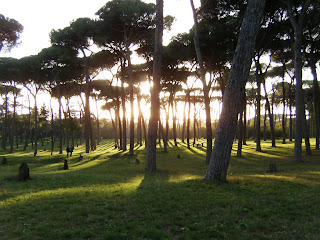
Well, two weeks, actually. Last week, we went to see the Vatican Museums for one of my classes. Emilio got us prepaid tickets, so we didn’t have to wait in the line that stretches right around the Vatican wall, and we spent most of the morning and part of the afternoon in the museums, wandering from one famous work of art to the next. We all brought our passports, hoping that, since the Vatican City is in fact its own country, we would get our passports stamped, but alas, ‘twas not meant to be, though the entrance to the museums was like an airport security checkpoint on steroids. Metal detectors, guards everywhere, tourists pulling out pocket knives and asking loudly whether or not they would have to give them up. It was fun.
Last weekend, we went to tour the Veneto, the region of northern Italy where Venice, Verona, and Vicenza are located. We took off Friday morning (early Friday morning) and didn’t get back until late Tuesday night. Our day trips to Vicenza and Verona were neat, but it was pouring rain and freezing cold, so that kind of put a damper on things. In Vicenza, we got to see the Theatro Olimpico, a Roman-type theater built by Palladio in the 1580s. It is said that it is the oldest surviving enclosed theater in the world, home to the oldest surviving stage set in the world.
In Verona, we saw the castle, ate (amazing!) Chinese food, and then talked Emilio into taking us to see Juliet’s Wall. Just FYI, they don’t actually allow you to post letters to Juliet on the wall. The thing to do is sign the wall of the tunnel leading to her courtyard. And the house is in the midst of Verona’s shopping district, so the cute little cafes and whatnot shown in the movie are really clothing and leather stores. Needless to say, we were rather disappointed. Some of the girls paid the entry fee to go inside Juliet’s house, and they found some sort of email thing to post their letters, but it’s just not the same thing. It was worth a shot though.
Venice. Ah, Venice. I think that might be the coolest city I’ve ever visited. It reminded me of Labyrinth, the 1986 Jim Henson film starring David Bowie. Imagine narrow streets (I say narrow, and you’re probably thinking charming-medieval-maze-narrow, but I’m talking turn-sideways-to-pass-another-person-narrow) that climb and descend bridge after bridge, run into dead ends on canals, and simply go through buildings instead of around them. That’s the Labyrinth. Now, line those streets with shops selling Carnevale masks that range from breathtakingly beautiful (I bought one of those) to downright grotesque. Those would be the goblins. Add to that the fact that time plays all kinds of games within the city, and it’s not too much of a stretch to imagine a Goblin King playing with a 13-hour clock and singing about magic spells in that palazzo you just can’t quite seem to reach.
We reached the city by crossing the lagoon from the mainland on the train, and when we exited the train station into the bright Adriatic sunshine, I couldn’t help it: I gasped. I’d seen plenty of pictures of Venice and the Grand Canal. I knew that it was there and how the whole system worked, but I didn’t know, you know? The sight of the water buses, gondolas, and yes, even the trash barges, sailing through the glittering blue water between the buildings, like it was the most natural thing in the world, got me. There were no words to describe my amazement. If I remember correctly, the first thing I did in Venice upon exiting the train station was turn to Bonnie and say, quite eloquently I might add, “Wow.”
 These signs were right around the corner from our hotel on the grand canal. The Venetians are
These signs were right around the corner from our hotel on the grand canal. The Venetians are so
helpful.... Despite their best efforts, we found our way to and from both the Rialto Bridge and the Piazza San Marco (with the Doge's Palace) on our own. Repeatedly. I feel very accomplished.


























